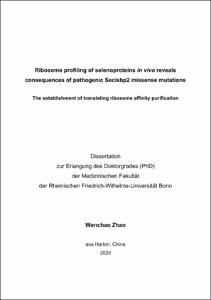Ribosome profiling of selenoproteins in vivo reveals consequences of pathogenic Secisbp2 missense mutationsThe establishment of translating ribosome affinity purification

Ribosome profiling of selenoproteins in vivo reveals consequences of pathogenic Secisbp2 missense mutations
The establishment of translating ribosome affinity purification

| dc.contributor.advisor | Schweizer, Ulrich | |
| dc.contributor.author | Zhao, Wenchao | |
| dc.date.accessioned | 2020-11-04T13:21:54Z | |
| dc.date.available | 2020-11-04T13:21:54Z | |
| dc.date.issued | 04.11.2020 | |
| dc.identifier.uri | https://hdl.handle.net/20.500.11811/8747 | |
| dc.description.abstract | Recoding of in-frame UGA/Seccodon in selenoproteins requires a complex translational machinery. The core of this event is the interaction between selenocysteine insertion sequence (SECIS element) in the 3’UTR of eukaryotic selenoprotein mRNAsandSECIS-binding protein 2 (SECISBP2). SECISBP2 consists of three domains: N-terminal domain, Sec incorporation domain (SID) and RNA binding domain (RBD). N-terminal domain of Secisbp2 remains unclear, while the sum of SID and RBD domains (C-terminal domain) accounts for essential Secisbp2 function (facilitating selenoprotein translation). Patients carrying pathogenic SECISBP2 mutations displayed a spectrum of clinical phenotypes. The most common outcome is abnormal thyroid hormone level caused by the deficiency of deiodinase, a selenoprotein that regulates thyroid hormone. In order to investigate the correlation between genotype and phenotype on molecular basis,two pathogenic human SECSISBP2 missense mutations (R540Q and C691R) were selectedand reproduced in mice (R543Q and C696R).Unexpectedly, both homozygous Secisbp2 mutant mice were embryonic lethal. Therefore, hepatocyte and neuron conditional Secisbp2 mutant mice were generated for further study. Regardless of in vivo or in vitro, the C696R substitution in the RBDdomain abrogates SECIS binding function and does not support selenoprotein translation above thecomplete loss of Secisbp2. The R543Q missense substitution located in the SID domainleads to a residual activity in vitro and reduced selenoprotein expression in vivo. Further experiment showed that Secisbp2 R543Q is thermally unstable in vitro andundetectable in the liver, while being partial functional in the brain. Therefore, the interrogation of how this partial functional Secisbp2 R543Q in the brain impacts on selenoprotein expressionis the priority. The R543Q mutation in the brain resulted in reduced selenoprotein translation evidenced by western blot and ribosome profiling. Combiningwith transcriptomic data, theexpression of individual selenoproteins was affected by Secisbp2 R543Q in different ways.Selenoproteins like Gpx1 and Selenow were reduced both in transcriptional and translational level. Selenoprotein like Gpx4 was not changed in transcriptional level, but remarkable reduced in translational level due to the inefficient UGA/Sec recoding. The effect of Secisbp2 R543Q on selenoprotein expression is gene-specific. Apart from reduced selenoproteins, a mild immune response was observed in the neuron-specific Secisbp2 R543Q mouse cortex. Overall, differential SECISBP2 protein stability in individual cell types may dictate clinical phenotypes to a much greater extent than molecular interactions involving a mutated amino acid in SECISBP2. Additionally, a single missense mutation can affect selenoprotein expressionvia different mechanisms which means that the hierarchy of selenoproteins is not simply a result of SECIS:SECISBP2 affinity.
The cellular diversity of heterogeneous tissue obstructs gene-function studies in a specific cell type, such as neurons inthe mammalian central nervous system (CNS). A novel methodology, translating ribosome affinity purification (TRAP), is one way to address this limitation. In order to establish and validate this robust method,TRAP was performed on neuron-specific Trit1 knockout mouse model (CamK-Trit1 KO). The interbreeding between TRAP mice and CamK-Trit1 KO mice did not have side effects on original mouse model, while both presented similar phenotype. Differential analysis of TRAP dataset showed that the effect of the loss of Trit1 on neuronal transcripts was amplified compared to non-TRAP dataset, indicating thewell-establishment and feasibility of TRAP method. | en |
| dc.language.iso | eng | |
| dc.rights | In Copyright | |
| dc.rights.uri | http://rightsstatements.org/vocab/InC/1.0/ | |
| dc.subject | Secisbp2 | |
| dc.subject | Selenoprotein | |
| dc.subject | TRAP | |
| dc.subject | Ribosome Profiling | |
| dc.subject.ddc | 500 Naturwissenschaften | |
| dc.subject.ddc | 540 Chemie | |
| dc.subject.ddc | 570 Biowissenschaften, Biologie | |
| dc.subject.ddc | 610 Medizin, Gesundheit | |
| dc.title | Ribosome profiling of selenoproteins in vivo reveals consequences of pathogenic Secisbp2 missense mutations | |
| dc.title.alternative | The establishment of translating ribosome affinity purification | |
| dc.type | Dissertation oder Habilitation | |
| dc.publisher.name | Universitäts- und Landesbibliothek Bonn | |
| dc.publisher.location | Bonn | |
| dc.rights.accessRights | openAccess | |
| dc.identifier.urn | https://nbn-resolving.org/urn:nbn:de:hbz:5-60227 | |
| ulbbn.pubtype | Erstveröffentlichung | |
| ulbbnediss.affiliation.name | Rheinische Friedrich-Wilhelms-Universität Bonn | |
| ulbbnediss.affiliation.location | Bonn | |
| ulbbnediss.thesis.level | Dissertation | |
| ulbbnediss.dissID | 6022 | |
| ulbbnediss.date.accepted | 27.10.2020 | |
| ulbbnediss.institute | Medizinische Fakultät / Institute : Institut für Biochemie und Molekularbiologie (IBMB) | |
| ulbbnediss.fakultaet | Medizinische Fakultät | |
| dc.contributor.coReferee | Witke, Walter |
Dateien zu dieser Ressource
Das Dokument erscheint in:
-
E-Dissertationen (1939)




